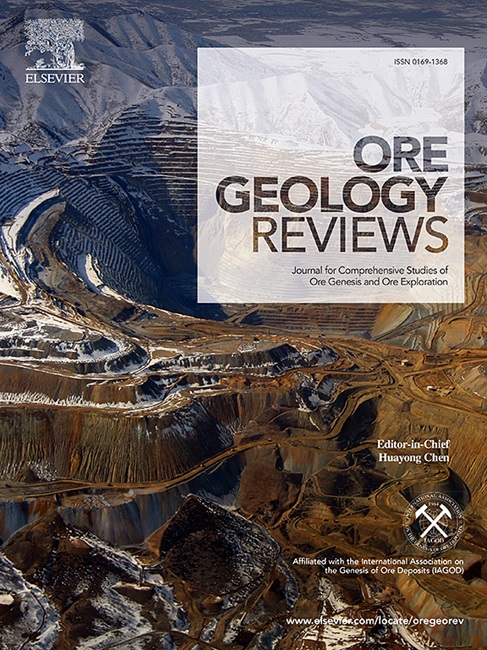Petrogenesis and evolution of internally zoned pegmatites: A tourmaline perspective from the Dakalasu deposit, Chinese Altai
IF 3.2
2区 地球科学
Q1 GEOLOGY
引用次数: 0
Abstract
The role of fractional crystallization and partial melting on pegmatite is controversial. To constrain the evolution and petrogenesis of internally zoned pegmatites, we selected the Dakalasu No. 1 pegmatite dike, Chinese Altai, as a case, and used tourmaline as a probe. Tourmalines were developed along the boundary between pegmatite and the host biotite granite porphyry (Tur BⅠ), at the border zone Ⅱ (Tur BⅡ) and further at the intermediate zone (Tur IM), but absent in the central zone of the pegmatite. All the tourmalines belong to alkaline schorl series. Tur BⅠ exhibits elevated concentrations of Mg (3.42–4.63 %) and V (104.2–263.4 ppm), coupled with low Al content at Y site, indicative of interaction between pegmatite and the host biotite granite. Tur BⅡ and Tur IM have high ratios of Fe/Mg (5.00–6.70), but low Mg/(Mg + Fe) (0.13–0.18), suggestive of a magmatic origin. The contents of rare metals (Li, Be, Nb, Ta, and Sn) of tourmaline increase inward, whereas the contents of Mg, Ca, Sr, Ni, V, Cr and the ratio of Mg/(Mg + Fe) decrease, suggesting a sequential evolution from the border to the intermediate zone. All tourmalines contain low content of Li, indicating a limited fractional crystallization. Boron isotopes (δ11B = −15.84 ‰ – −14.55 ‰) in tourmaline indicate that the pegmatite dike originates from the low-degree partial melting of metasedimentary rocks, rather than fractional differentiation of the host granite. We propose that tourmaline in zoned pegmatites can be employed as a pathfinder to explore the petrogenesis and evolution of pegmatite.

内分带伟晶岩的成因与演化——以中国阿尔泰达卡拉苏矿床电气石为例
部分结晶和部分熔融对伟晶岩的作用是有争议的。为限定内分带伟晶岩的演化和成因,以中国阿尔泰达卡拉苏1号伟晶岩岩脉为例,以电气石为探针。碧玺主要发育在伟晶岩与寄主黑云母花岗斑岩(Tur BⅠ)的交界带Ⅱ(Tur BⅡ)和中间带(Tur IM),但在伟晶岩的中心地带不存在。电气石均属碱性系。图BⅠ中Mg(3.42 ~ 4.63%)和V (104.2 ~ 263.4 ppm)浓度升高,Y位Al含量低,表明伟晶岩与寄主黑云母花岗岩相互作用。图BⅡ和图IM的Fe/Mg比值较高(5.00 ~ 6.70),Mg/(Mg + Fe)比值较低(0.13 ~ 0.18),表明其岩浆成因。电气石中稀有金属(Li、Be、Nb、Ta、Sn)含量向内增加,Mg、Ca、Sr、Ni、V、Cr含量及Mg/(Mg + Fe)比值降低,呈现出从边界到中间的顺序演化过程。所有电气石的锂含量都很低,表明分馏结晶作用有限。电气石硼同位素(δ11B = - 15.84‰~ - 14.55‰)表明,该辉晶岩脉源于变质沉积岩的低程度部分熔融作用,而非寄主花岗岩的分异分异作用。我们认为,带状伟晶岩中的电气石可以作为探索伟晶岩成因和演化的探路者。
本文章由计算机程序翻译,如有差异,请以英文原文为准。
求助全文
约1分钟内获得全文
求助全文
来源期刊

Ore Geology Reviews
地学-地质学
CiteScore
6.50
自引率
27.30%
发文量
546
审稿时长
22.9 weeks
期刊介绍:
Ore Geology Reviews aims to familiarize all earth scientists with recent advances in a number of interconnected disciplines related to the study of, and search for, ore deposits. The reviews range from brief to longer contributions, but the journal preferentially publishes manuscripts that fill the niche between the commonly shorter journal articles and the comprehensive book coverages, and thus has a special appeal to many authors and readers.
 求助内容:
求助内容: 应助结果提醒方式:
应助结果提醒方式:


